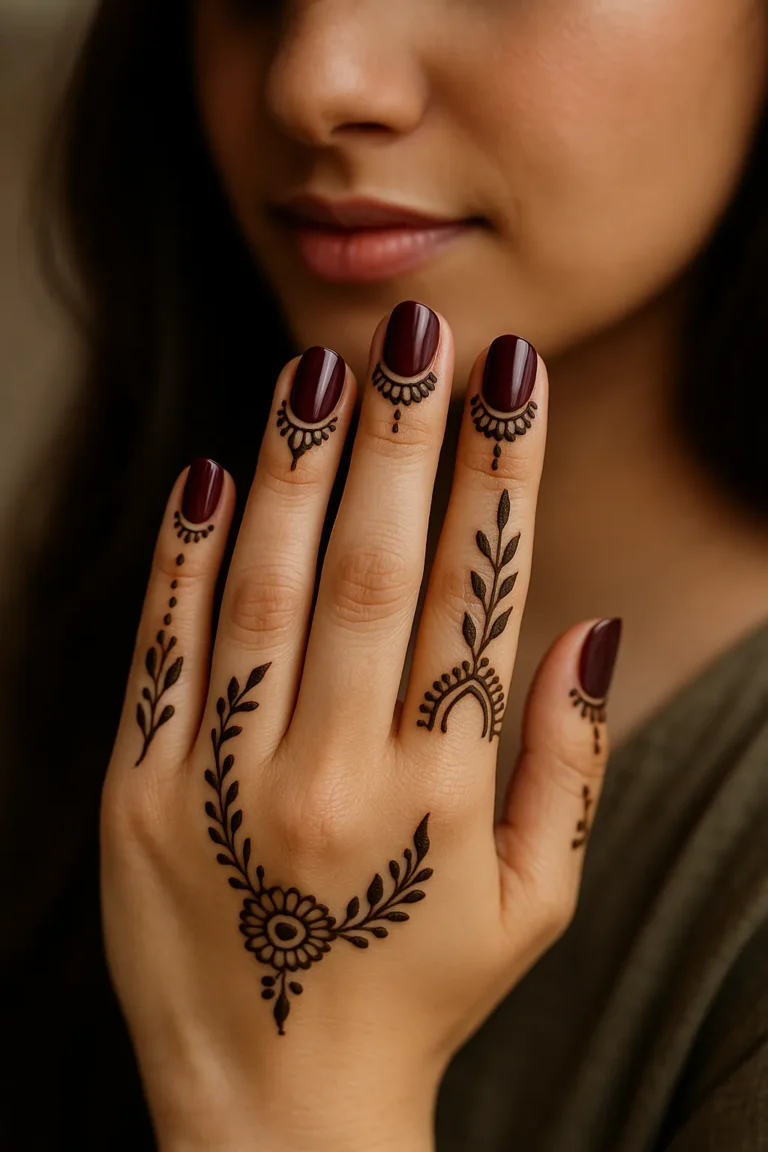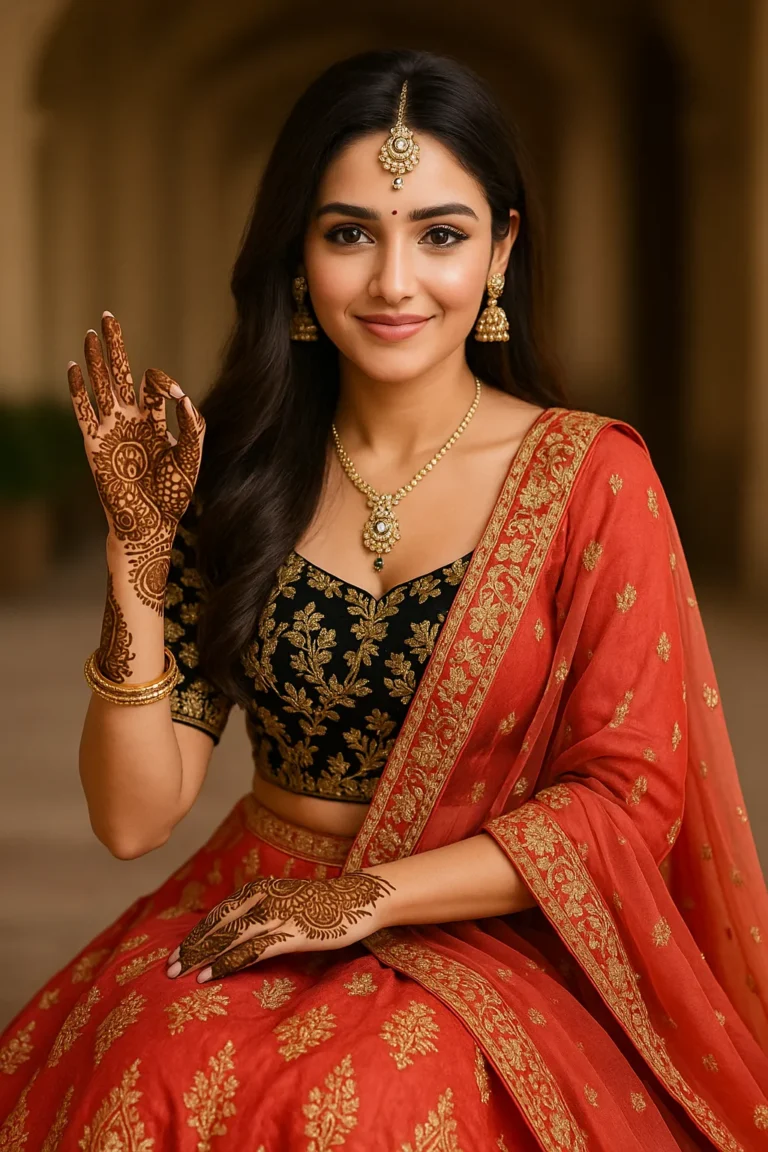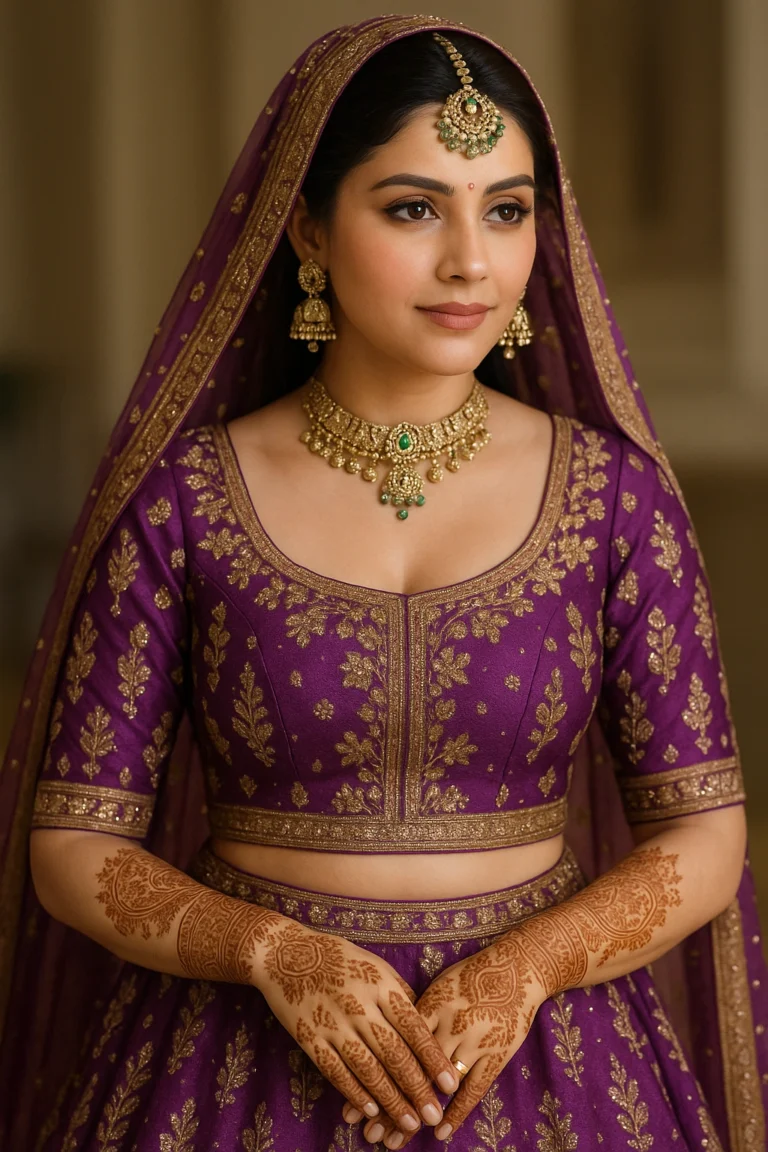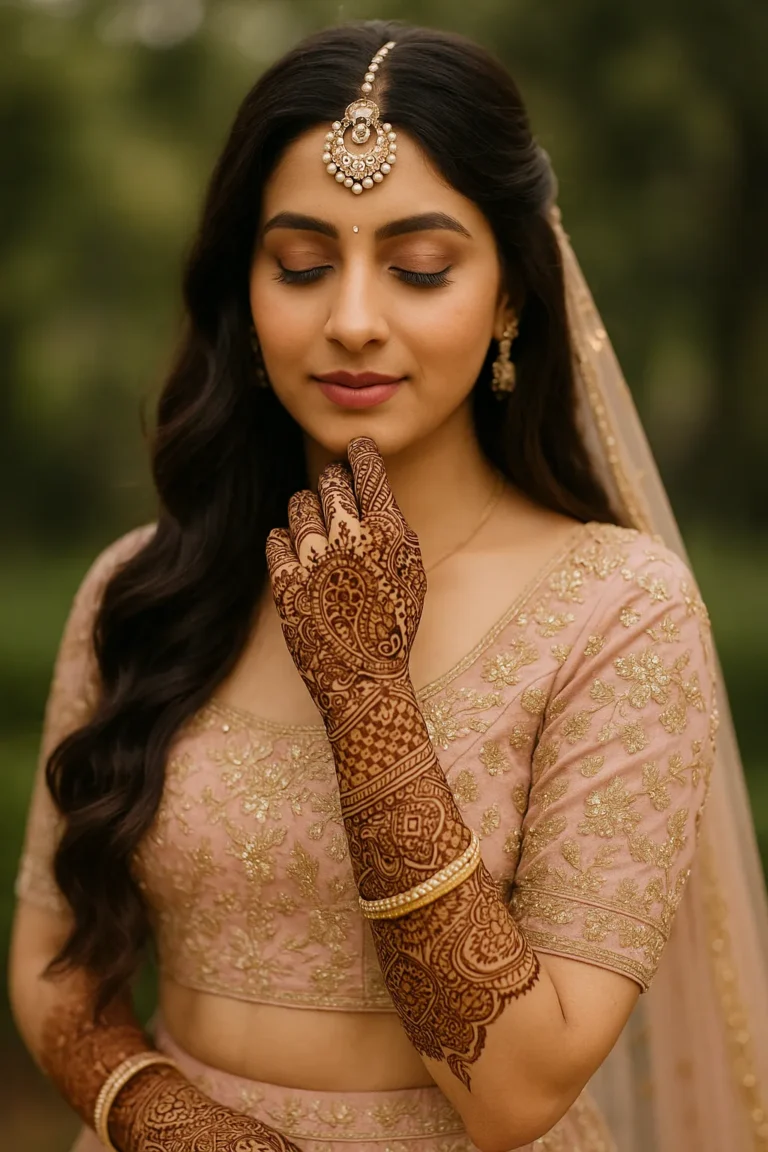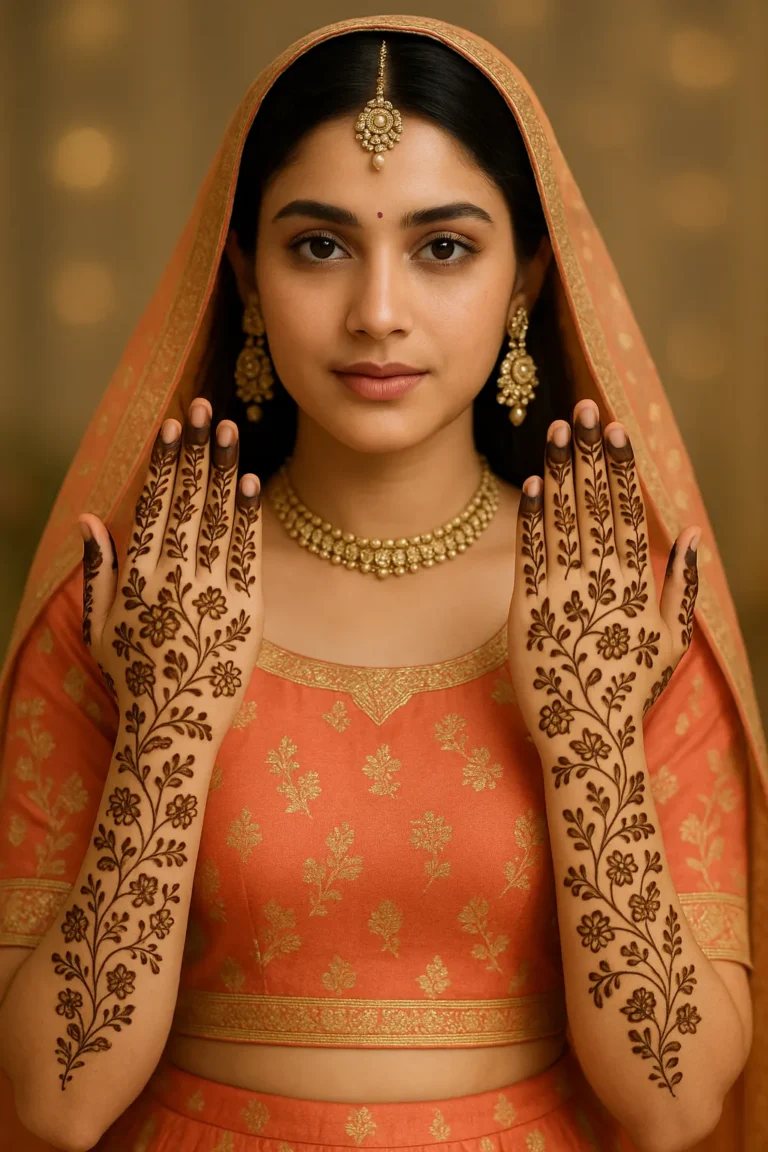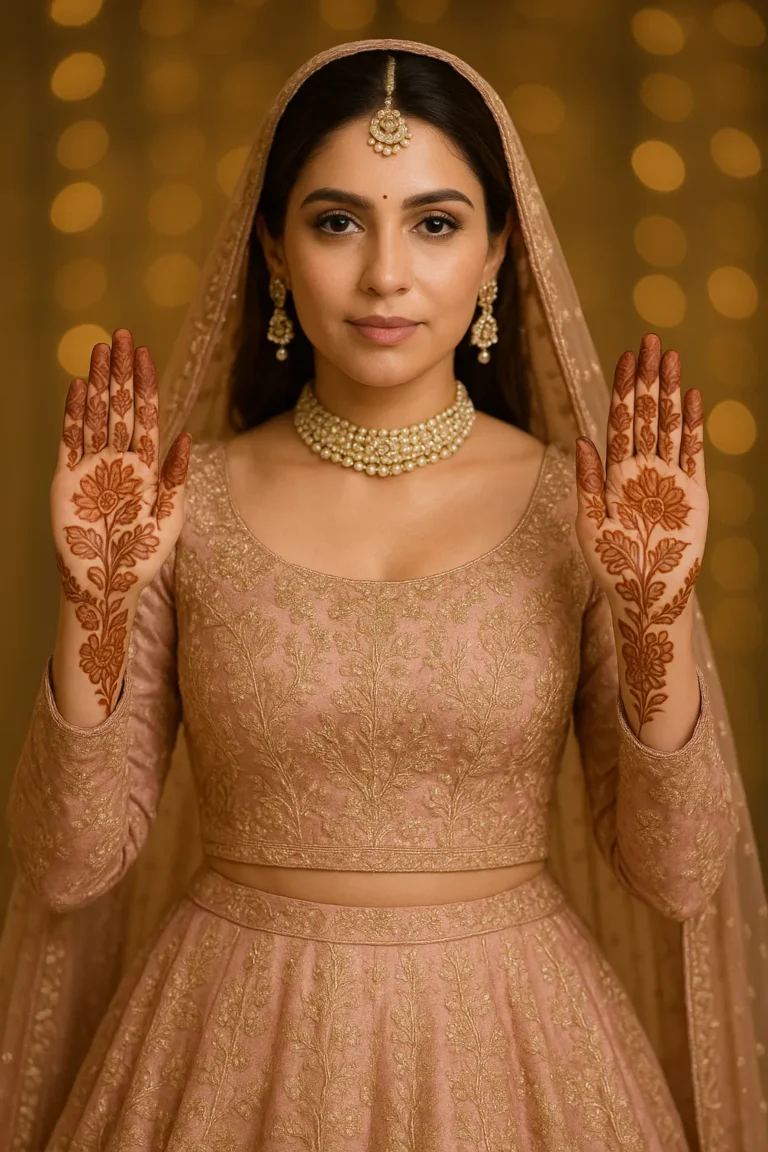Top Mehndi Styles in India – Arabic, Marwari, Indo-Western & More Explained
In a land as diverse as India, art takes on many forms—but perhaps none is as expressive and beautiful as mehndi. For centuries, Indian women have adorned their hands and feet with intricate patterns made from henna paste, a tradition steeped in culture, emotion, and symbolism. But mehndi is not just one uniform style. From the majestic portraits of Rajasthani mehndi to the flowing trails of Arabic patterns, every region has its unique interpretation.
In this guide, we explore the most popular mehndi styles in India, their cultural roots, visual elements, and when to choose each one. Whether you’re a bride-to-be, a festive enthusiast, or just someone curious about the art of henna, this article will help you discover the perfect mehndi design for every occasion.
🌿 What Makes Mehndi an Art Form?
Before we dive into specific styles, it’s important to understand why mehndi is more than decoration.
Mehndi, or henna, is made from the powdered leaves of the Lawsonia inermis plant. When applied to the skin, it leaves behind a reddish-brown stain that fades over time. But mehndi is much more than its chemical properties. It’s used during celebrations, rites of passage, and spiritual moments. Each design, shape, and stroke is a piece of cultural storytelling.
🧭 A Quick Glance at India’s Mehndi Styles
Here’s a breakdown of the major mehndi styles you’ll find across India and beyond:
| Style | Known For | Best For |
|---|---|---|
| Indian Mehndi | Dense, intricate designs with paisleys, flowers, and peacocks | Traditional weddings |
| Arabic Mehndi | Bold, floral trails with open spaces | Quick applications & Indo-western functions |
| Rajasthani Mehndi | Cultural portraits, symmetry, and storytelling | Royal weddings, grand ceremonies |
| Marwari Mehndi | Detailed lattice work, motifs, and elegance | Classic bridal elegance |
| Indo-Western Mehndi | Minimalist, geometric fusion | Photoshoots, modern brides |
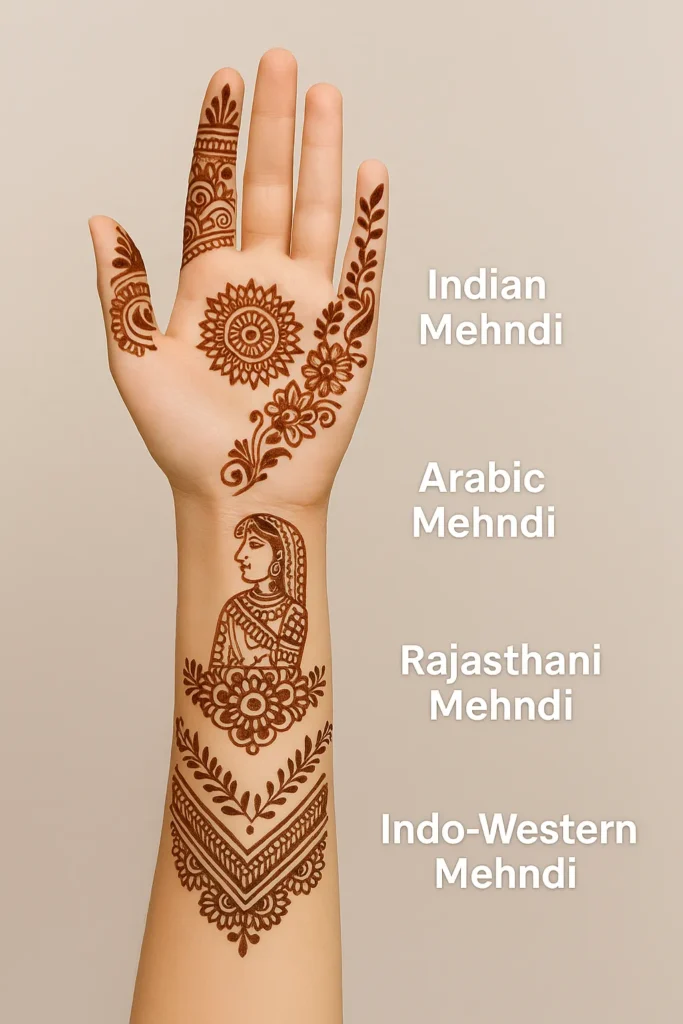
🌸 1. Indian Mehndi – The Heart of Tradition
If there’s one style that defines Indian culture, it’s the traditional Indian mehndi. These designs are known for their dense, no-skin-left-empty approach. From the fingertips to the elbows (and even beyond), every inch is filled with intricate patterns.
🌟 Key Features:
- Paisley patterns (mango shape)
- Flower vines
- Peacocks
- Mandalas
- Mesh (jaali) work
👰 When to Choose It:
Indian mehndi is best suited for brides, Karwa Chauth, and Diwali celebrations. The boldness and intricacy make it ideal for long events where the stain develops deeply.
💡 Tip:
Indian designs often include symbolic elements like kalash (pots), mangal sutra, or dulha-dulhan portraits for weddings.
🌹 2. Arabic Mehndi – Flowing Beauty with Bold Florals
Arabic mehndi is globally loved for its quick application and visually striking flow. It originated from the Gulf regions but has blended beautifully with Indian styles.
🌟 Key Features:
- Bold outlines
- Open spaces
- Floral and leafy vines
- Diagonal wrist-to-finger trails
👗 When to Choose It:
Perfect for Eid, casual parties, or when you’re short on time. Arabic mehndi is often used by bridesmaids, mothers, or models during pre-wedding shoots.
💡 Tip:
Mix Arabic mehndi with glitter or white mehndi for a modern twist.
🏰 3. Rajasthani Mehndi – The Royal Tapestry
This style is inspired by the royal heritage of Rajasthan and is known for its complex, symmetrical storytelling. If you want mehndi that tells a story—this is the one.
🌟 Key Features:
- Dulha-Dulhan portraits
- Elephants, camels, musical instruments
- Mandap scenes
- Dense, mirror-image designs on both hands
👑 When to Choose It:
Ideal for grand weddings, especially destination weddings in palaces or heritage venues. It’s a favorite among traditional North Indian brides.
💡 Tip:
Rajasthani mehndi can take hours to apply—plan ahead and ensure proper seating and rest time for the bride.
How to Make Mehndi at Home – Step-by-Step Natural Cone Recipe
💫 4. Marwari Mehndi – The Hidden Beauty of Rajasthan
While often confused with Rajasthani mehndi, Marwari mehndi has its own unique style. It blends detailed motifs with elegance and lightness, often including fine curves and netted textures.
🌟 Key Features:
- Lotus flowers
- Diamond-shaped fillers
- Dots, curls, and symmetry
- Intricate finger tips and palm centers
💍 When to Choose It:
Perfect for brides who want richness without clutter. Works beautifully for smaller weddings or religious events.
💡 Tip:
Marwari mehndi can be adapted for both hands and feet, creating a full bridal look without being overwhelming.
🌐 5. Indo-Western Mehndi – Where Tradition Meets Trend
This is the style you’ll most likely see on Instagram brides and modern influencers. It fuses the best of Indian and Western minimalism—often with geometric designs, symbolic art, and lots of negative space.
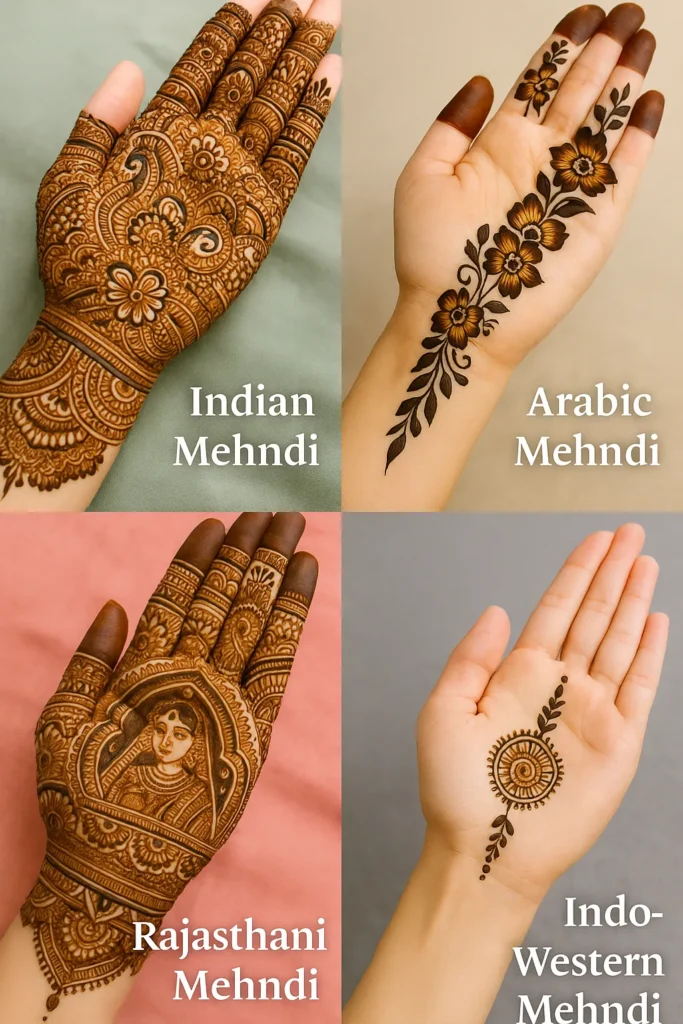
🌟 Key Features:
- Hearts, stars, initials
- Mandalas with space around them
- Geometric shapes like triangles, squares
- Only fingers or side-hand designs
👗 When to Choose It:
For engagements, pre-wedding shoots, festivals, or even casual occasions. Great for girls who want style over saturation.
💡 Tip:
Pair Indo-western mehndi with trendy outfits like lehenga skirts, Indo-fusion gowns, or jumpsuits.
🖌️ Bonus: Fusion Styles & Regional Variations
Besides the top 5, India is home to many local variations of mehndi. Some are lesser known but equally beautiful:
- Gujarati Mehndi – Celebratory with musical dandiya elements
- South Indian Mehndi – Simpler designs with religious motifs
- Kashmiri Mehndi – Floral and symmetrical, often hand-painted
- Pakistani Mehndi – Fusion of Indian + Arabic, heavy on fingertips
- Bengali Mehndi – Elegant with bold tips and minimal palm work
🤔 How to Choose the Right Mehndi Style for You
Not every mehndi style fits every occasion or personality. Here’s how to make the right choice:
| Personality | Best Style | Why |
|---|---|---|
| Traditional & cultural | Indian / Rajasthani | Symbolic and detailed |
| Bold & glam | Arabic / Indo-Western | Eye-catching and easy |
| Soft & elegant | Marwari | Rich but not overwhelming |
| Fun & expressive | Fusion / Geometric | Allows creativity |
| Minimalist | Finger-only / Mandala | Trendy and manageable |
🪷 Real-Life Example: My Wedding Mehndi Journey
When I got married in 2021, I was torn between Arabic and Rajasthani styles. I wanted something modern, but my family wanted tradition. Eventually, my mehndi artist created a fusion design—Rajasthani dulha-dulhan in the center with Arabic floral trails. It was perfect. Not only did I get a stunning design, but it also felt personal.
That’s the beauty of mehndi—it allows you to customize your emotions into art.
💬 Most Common Questions About Mehndi Styles
Q. Can I mix styles in one design?
Absolutely. Many brides mix Rajasthani palms with Arabic arms or Indo-Western fingers with Indian bases.
Q. Which style lasts the longest?
All styles can last equally well if applied with natural henna and proper aftercare.
Q. Are there styles for men?
Yes! Many modern grooms opt for subtle mehndi with initials, wedding date, or small motifs on their palms or arms.
Q. How do I find the right artist?
Look at their portfolio. Choose someone who specializes in the style you want, and book them early in wedding season.
🎯 Final Thoughts: Mehndi is Expression, Not Just Tradition
In today’s world, mehndi has grown far beyond the borders of culture or ritual. It’s become a form of personal style, celebration, and even relaxation. Whether you’re choosing a bridal design or a casual festival trail, remember this:
Mehndi doesn’t just sit on your skin—it tells your story.
So explore the different styles, mix and match, or even invent your own. Because when tradition meets creativity, magic happens right on your hands.
